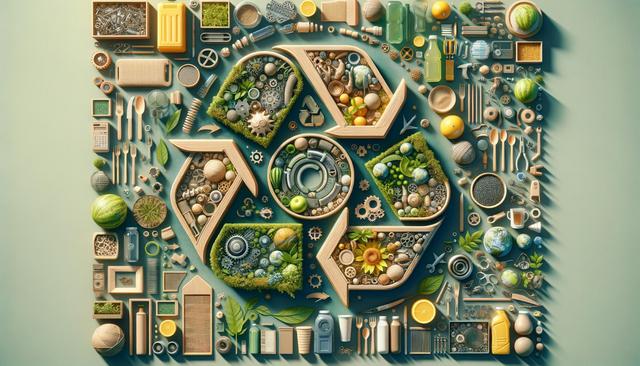Understanding the Circular Economy Model
The circular economy is a regenerative system aimed at minimizing waste and making the most of available resources. Unlike the traditional linear economy, which follows a ‘take-make-dispose’ approach, the circular model focuses on designing out waste, keeping products and materials in use, and regenerating natural systems. This method reimagines how materials flow through our economy and encourages businesses and consumers to rethink consumption patterns. By shifting toward circular models, organizations can reduce dependency on finite resources and lower their environmental impact while creating new economic opportunities.
Key principles of the circular economy include:
- Designing products for longevity, reuse, and recyclability
- Keeping materials and products in use through maintenance, refurbishment, and remanufacturing
- Recycling materials to eliminate waste
- Shifting to renewable energy sources and sustainable inputs
These principles not only help reduce environmental degradation but also promote more resilient economies by decoupling growth from resource consumption.
Benefits of Circular Economy Solutions in Business
Businesses are increasingly adopting circular economy solutions to align with sustainability goals, reduce costs, and meet customer expectations for environmentally responsible practices. By integrating circular strategies, companies can unlock value at every stage of the product lifecycle. This includes sourcing materials responsibly, designing for modularity, and offering services that extend product life, such as repair or leasing programs.
Some of the tangible benefits businesses experience include:
- Lower raw material costs through reuse and recycling
- Increased customer loyalty through sustainable offerings
- New revenue streams from resale, refurbishment, or product-as-a-service models
- Stronger compliance with environmental regulations
Additionally, circular economy models can enhance brand reputation and attract eco-conscious consumers and investors. Many organizations are now incorporating lifecycle assessments and circularity metrics into their reporting to demonstrate progress and transparency.
How Circular Design Drives Innovation
Product design plays a critical role in enabling circular economy practices. Circular design involves creating products with their entire lifecycle in mind—from sourcing sustainable materials to considering end-of-life recovery. This approach encourages innovation by requiring designers to think beyond aesthetics and functionality to include repairability, modularity, and recyclability.
Circular design strategies include:
- Using mono-material components for easier recycling
- Designing for disassembly to facilitate repair and reuse
- Incorporating recycled or biodegradable materials
- Developing modular systems that allow for upgrades instead of replacement
These innovations not only contribute to sustainability but can also differentiate products in competitive markets. Companies that embrace circular design are often seen as forward-thinking and responsible, helping them build stronger relationships with stakeholders.
Community and Consumer Engagement in Circular Economy
For the circular economy to succeed, consumer and community participation is essential. Educating the public about responsible consumption, recycling practices, and the benefits of reuse can drive behavioral change. Community-based initiatives such as tool libraries, repair cafés, and local recycling programs empower individuals to participate directly in circular practices.
Effective engagement strategies include:
- Providing incentives for returning used products
- Launching awareness campaigns about product lifecycle and waste reduction
- Creating platforms for sharing, renting, and borrowing goods
- Encouraging co-creation and feedback in product development
When consumers understand the impact of their choices and have access to circular options, they are more likely to support sustainable businesses. At the same time, communities that embrace these models can reduce local waste, lower environmental impact, and strengthen economic resilience.
Policy and Infrastructure for Scaling Circular Solutions
Governments and institutions play a crucial role in enabling and scaling circular economy solutions. Policy frameworks that support extended producer responsibility, waste reduction targets, and green public procurement can create favorable conditions for circular business models. Moreover, investment in infrastructure—such as advanced recycling facilities and materials recovery systems—is necessary to support the practical implementation of circular practices.
Important policy measures include:
- Tax incentives for circular design and remanufacturing
- Standards and labeling for recyclable and sustainable products
- Funding and grants for circular economy research and innovation
- Public-private partnerships to develop circular supply chains
Infrastructure and policy must evolve in tandem with market demands to ensure that circular solutions are not only viable but scalable. With the right support, regions can foster innovation, reduce environmental impacts, and create green jobs that contribute to long-term sustainability.
Conclusion: Embracing Circular Economy for a Sustainable Future
Adopting circular economy solutions offers a practical and impactful path toward sustainability. By rethinking how products are designed, used, and disposed of, businesses, communities, and governments can collectively reduce environmental pressures and build more resilient systems. These strategies do more than just reduce waste—they promote innovation, create economic opportunities, and encourage responsible consumption. For organizations and individuals alike, embracing the circular economy is a step forward in creating a more sustainable and equitable future.




Leave a Reply